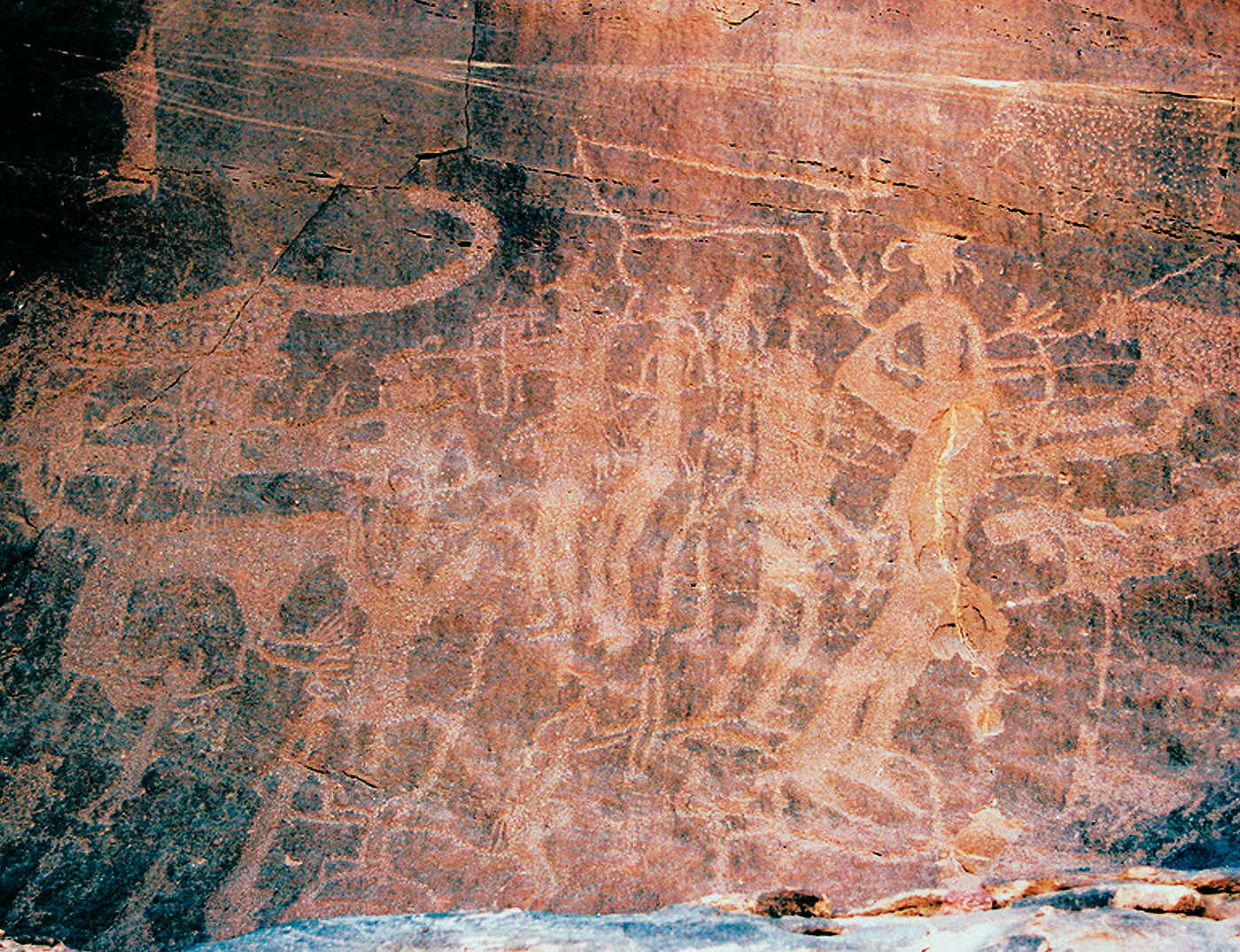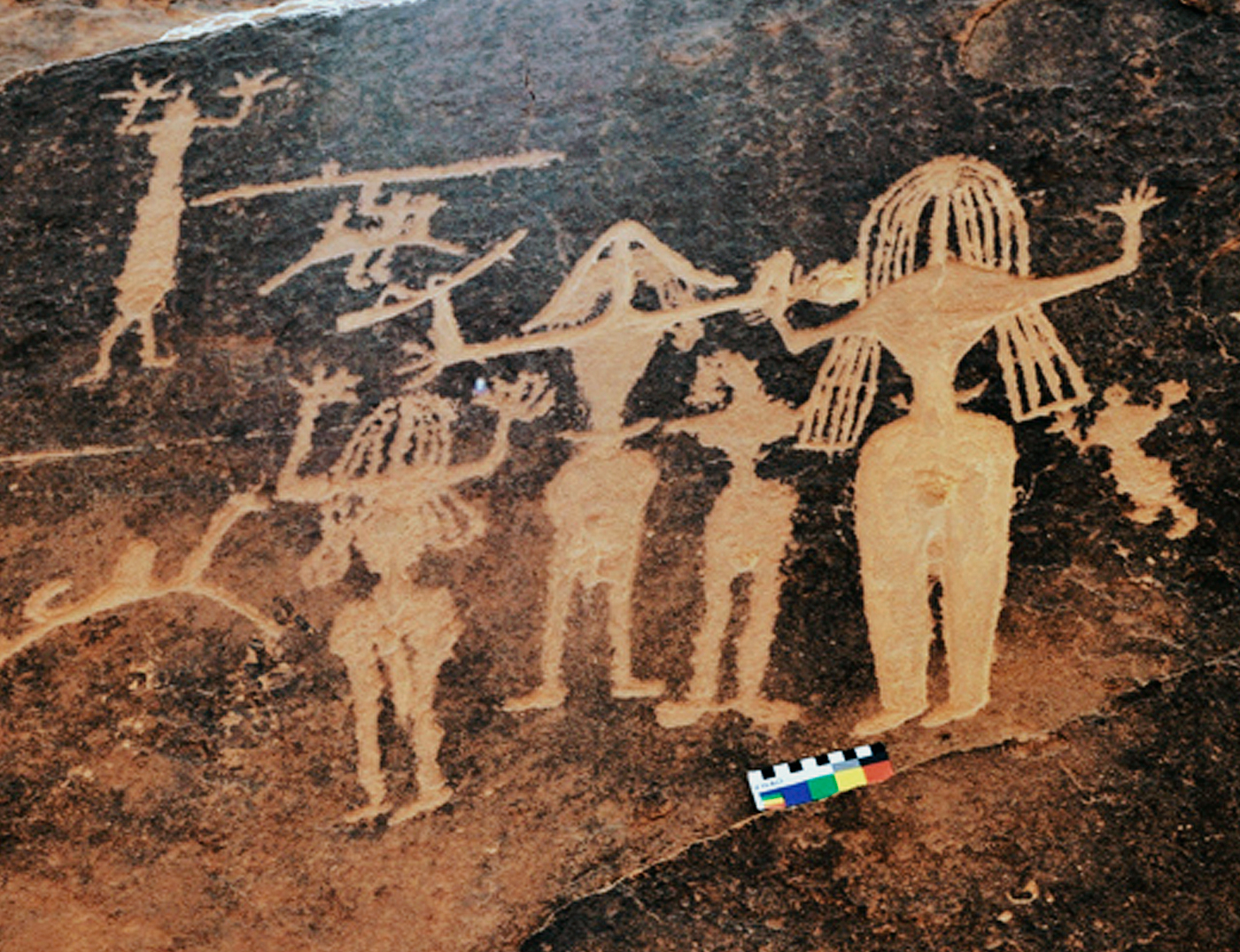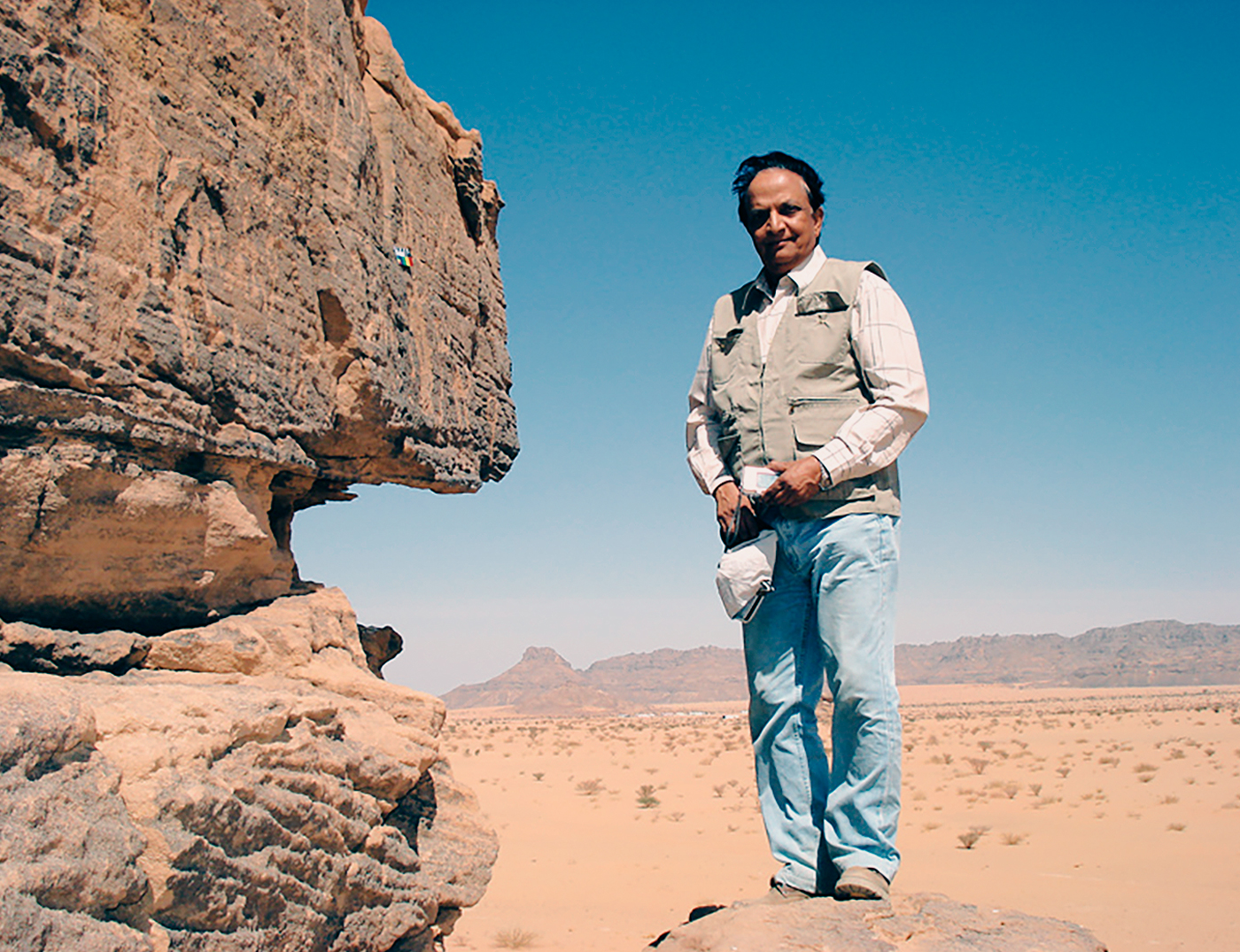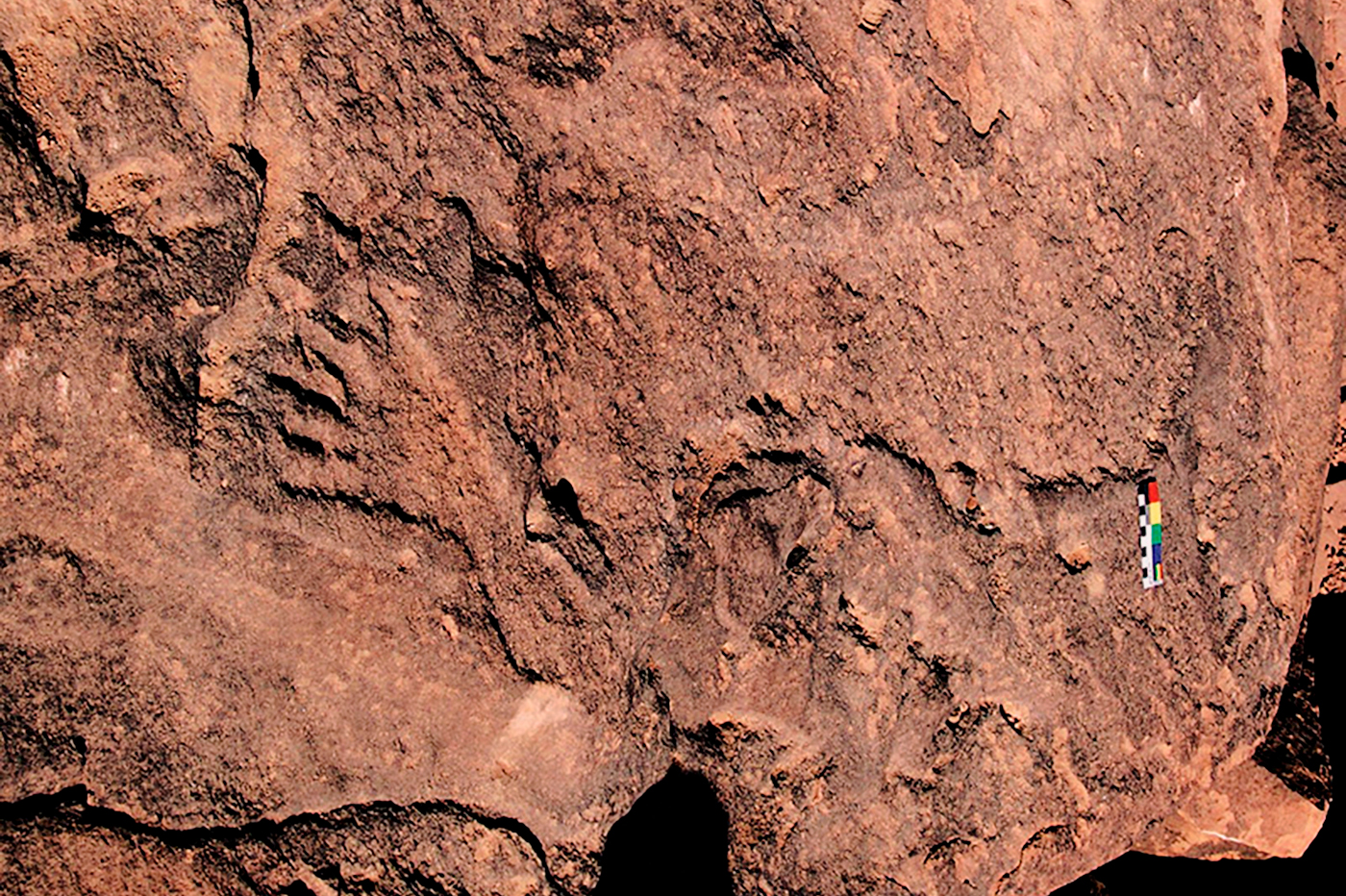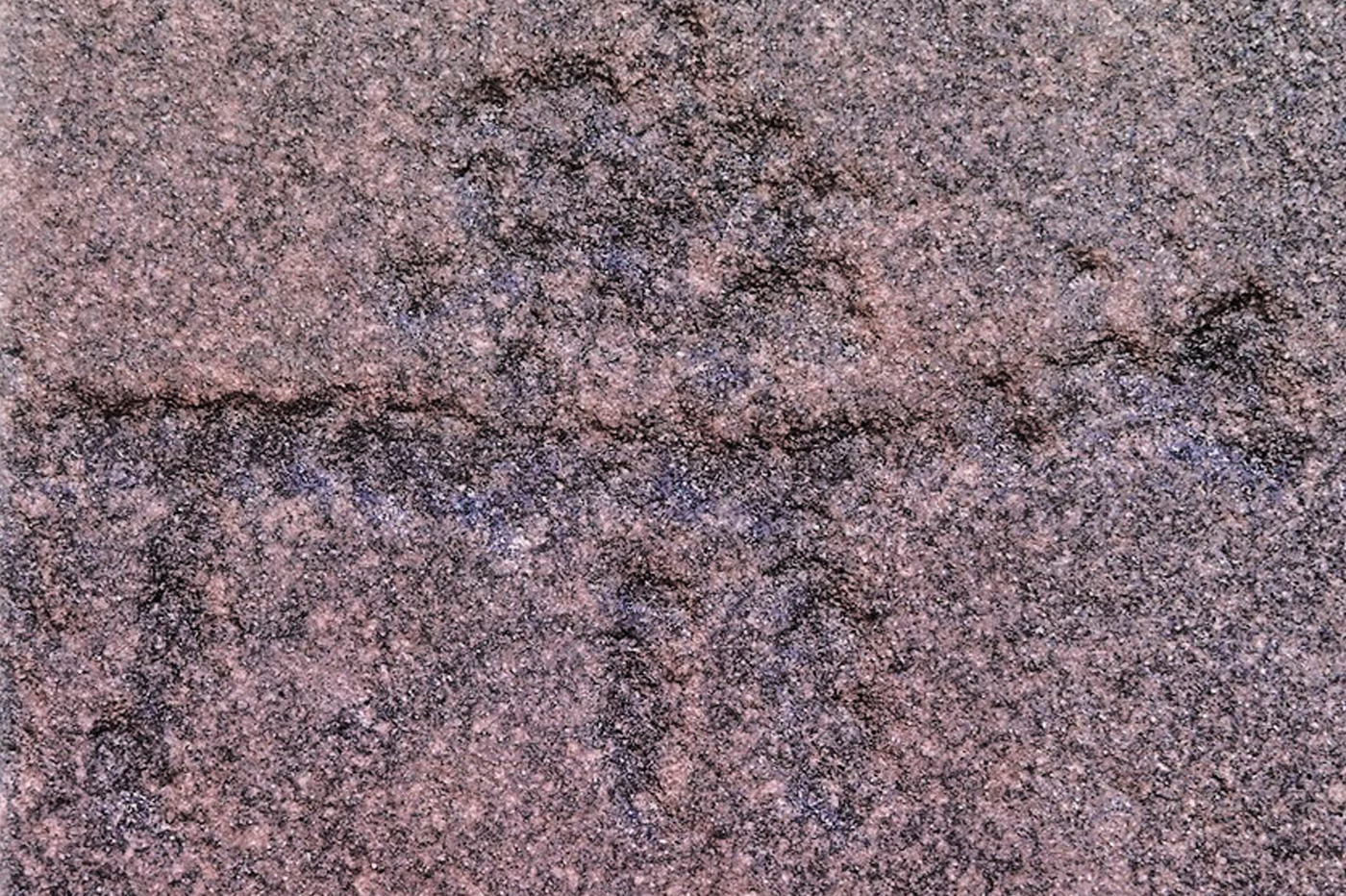



The Kingdom of Saudi Arabia has a rich cultural heritage: of its more than four thousand registered archaeological sites, one thousand five hundred include rock art, and many more are no doubt still waiting to be discovered. The settlement of the peninsula began in the Acheulean era (one million years ago), but the earliest examples of rock art date from the early Neolithic, around 12,000 BP, and this form of expression endured until the advent of the Islamic period, c. 650 AD.
The cultural origins of the Arab nomads, or Bedouins, are rooted in prehistory, in particular the tribal system that has perpetuated powerful social and cultural traditions since Antiquity.
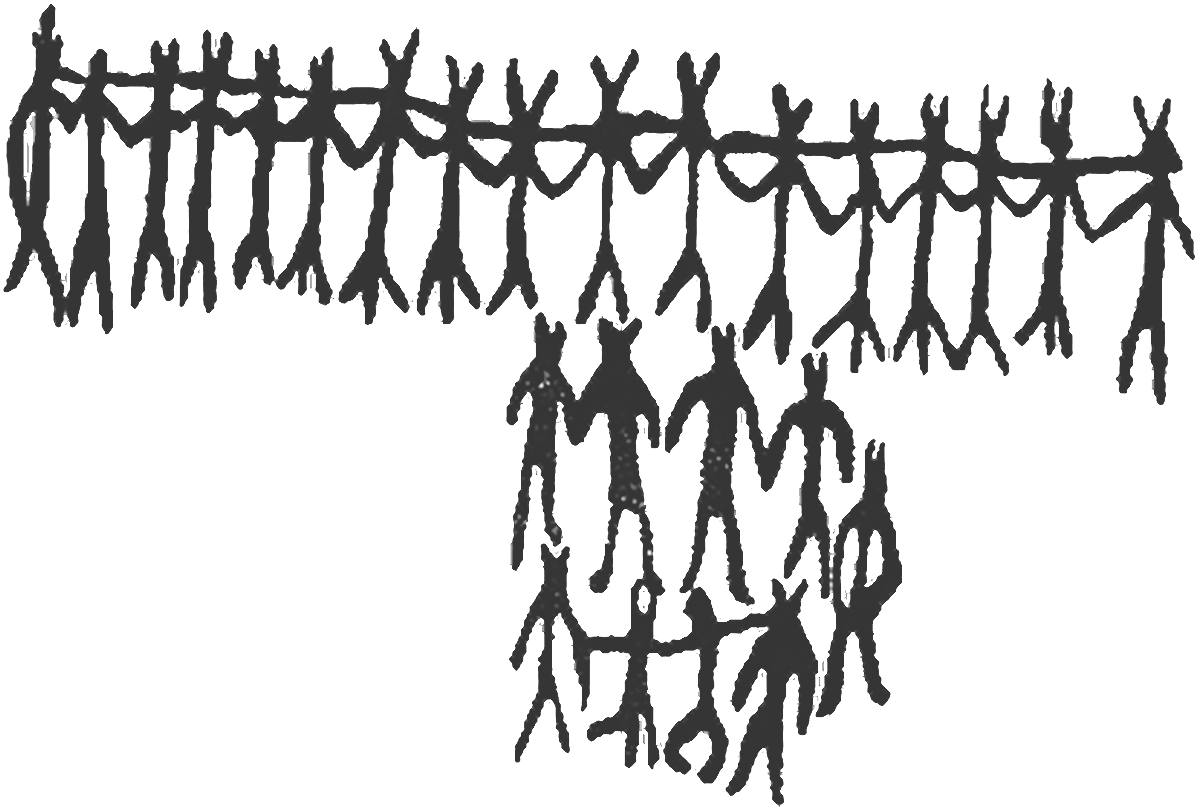
It is tempting to see in the modern Bedouins' devotion to tribal links and the cultural and social values of their respective tribes - like the dances - the survival of cultural traditions that have been handed down since prehistoric times.
In nearly all the compositions that can be attributed to the Neolithic period, between about 10,000 and 7,500 BP, the human figures are associated with animals, especially cattle and dogs. Presumably these animals had been domesticated and were part of the everyday life and the social and cultural activities of the early tribes.
Rock art depicted social and religious events; men and women dancing in a group. Are they masked humans or mythological beings with a human body and an animal head? Mythological beings were also represented as 'storm gods'.
As they became sedentary, men built temples and sculpted images of their deities in stone or cast them in metal, but they also continued to carve them on rock faces. One intriguing female figure was chiselled into a hard sandstone surface at the peak of a 200-metre hill, facing east. The rays of the rising sun fall directly onto the image, which is visible at a great distance. It can be interpreted as a mother goddess, the goddess of love and fertility.
A number of similar depictions of goddesses have been found in the Najran area, with wide hips, hands half raised, palms open and fingers extended. Hunting scenes are symbolic and the animals in them are never depicted wounded or pierced with arrows. Are they illustrations of magical practices, specific events or rites performed to ensure a bountiful hunt? All of these assumptions could simply be hypotheses bolstered by our modern point of view.
One of the earliest signs of human presence in Arabia is a nearly life-size representation of a human footprint (right) carved deep into the horizontal surface of a sandstone boulder at Shuwaymis in northern Saudi Arabia. The oldest such print ever found on the Arabian Peninsula, it dates from c. 10,000 to 8,000 BP. Representations of handprints with open palms and extended fingers have been found on one of the vertical surfaces of a hill in the northwestern Tabuk region. The date remains unknown. The hyena and dog were added later.
A few petroglyphs are accompanied by inscriptions - 'fight_scene' two women apparently in the midst of a fight, plus a third woman watching them with arms raised, as though she were a kind of referee reminding them to obey the rules of combat. Each of the two inscriptions gives the name of a person: it is possible to decipher B-j a dh, or Bajadh, on top and B- Pbh, or Balabh, below. These could be the names of the two opponents. The inhabitants of Arabia continued to create rock art after the invention of writing. Bedouin writing, the earliest tribal writing system, also known as 'Thamudic' script, was rudimentary. Only the names of persons or tribes have been found carved on the rocks; no extended inscription has yet been discovered.
The gradual change of style, content, context and conceptualization between prehistoric art and tribal or Bedouin art can be traced through the use of animal figures, tribal symbols and the later developments of Bedouin writing in the early Iron Age. The depiction of Bedouin folk dances and branded camels, as well as the presence of names of tribes or individuals carved next to certain images, show that rock art played an important role in the description of the social, cultural and religious entities of Arabia from the Prehistoric period up to the beginning of the Islamic era.
The beginning of the large-scale domestication of the camel, which went hand-in-hand with the sedentarization of large communities and the development of tribes and clans, is evidenced in the rock depictions by the inclusion of brands, locally called wusum. Each tribe used a specific mark to define its territories, sign documents and differentiate its tombs, tents and encampments. The branding of animals is a universal phenomenon. Still practised in modern times on horses and livestock, in Arabia it is an ancient tradition deeply rooted in the local customs. The Bedouins still roaming the desert today use geometrical or non-figurative motifs to denote their respective tribes. They have not left their territories for millennia, and their social and cultural values remain unchanged. The wusum system is a sort of code developed for limited use relying on a complex combination of non-phonetic signs. These wusum are symbols related to language or writing but instantly conveying their meaning, like traffic signs that require no linguistic knowledge and are understandable by all.
The people of Pre-Islamic Arabia venerated a great many different deities. In the desert, the nomadic Bedouins created open-air sanctuaries, carving representations of gods and goddesses on high-standing rocks.
At Wadi Bajdha, north-west of Tabuk in the northern part of the country, a rock art composition featuring bulls and human figures marks the location of an open-air sanctuary in the middle of the desert. As in Egypt, the bull was a sacred animal in Arabia. This tableau, whose date cannot be precisely determined, was carved about 5 metres above the present-day ground level on one of the smooth surfaces of a sandstone hill. Offerings might have been placed in the fissures below the image.
In another panel, the carving of female figures over earlier Bedouin inscriptions would indicate that they date from a period after the development of writing. These figures have a triangular torso with an elongated neck, narrow waist, wide hips and long hair. They could represent a goddess, perhaps Alia, the goddess of love and fertility. Several figures representing Alia appear on a readily visible vertical surface high up on a hill. The site is close to a watering place that is now dry, possibly a spring or a rainwater reservoir. Sheltering spots under the rock, water and a few plants made this an ideal location for social or religious gatherings. It is possible that rituals took place here and an image of the goddess was created each time, once per year or according to another periodicity. The site remained a gathering place for centuries: there are hundreds of ancient Arabic inscriptions carved all around the reservoir that have been dated to c. 1500 to 1000 BC.
These images of goddesses show that the artist(s) worked within precise guidelines, each time using the same theme, motif and style, from which they could not deviate. Some ancient artists probably specialized in religious images, always reproducing the same subject(s) with no formal or stylistic variation. This would explain why identical representations of the goddess Alia have been found at nearly all the sites. There must have been a few recognized artists who, conforming to their society?s religious and cultural prescriptions, depicted only authorized figures strictly according to the imposed rules, which explains the absence of aesthetic differences and indeed of variety in the artistic creations.
In the Najran region of southern Arabia, a prehistoric artist adorned the smooth surface of a large rock with one of the most remarkable and fascinating works of art ever created. When the sun rises each day, the figures of this panel, which faces east, gleam and sparkle in the first rays of sunlight. Originally the composition apparently consisted of only the male and female figures, plus the stag off to the right, which was carved using the same pecking technique and has the same kind of chisel marks as the main figures. Over time, this tableau lost its importance. The place was no longer considered sacred and the local population forgot about its traditions. Visitors began carving their own names and other texts on the rock and over the figures, which are nonetheless well preserved and still have all of their beauty and evocative power. This work has not been precisely dated, but it certainly preceded writing by at least two thousand years.
For a long time archaeologists thought that the Bedouins, as nomadic herders, had left few traces of their presence. But more recent studies, including many devoted to rock art, have disproved this assumption by discovering a considerable quantity of cultural materials in the deserts of Saudi Arabia. The animals depicted correspond to the local fauna: cattle, camels, stags, gazelles, dogs, snakes, lizards, goats, etc. The flora is surprisingly absent from the images, except for representations of date palms at a few sites, as are birds, with the exception of ostriches. The artists seemed to choose the elements of their compositions from among a few animals that were part of their environment, to the exclusion of others also present. This same phenomenon has been observed in Europe, Africa, Australia and Asia, indicating that artists in different parts of the world all shared the same mental, intellectual and ideological approach.
From the Neolithic to the early Islamic period, the evolution of rock art shows that the desire for aesthetic achievement is not specific to contemporary civilizations, but was already a deep-seated preoccupation in the minds of our ancestors.
Al-Magar site, amid the remote low hills and sandy valleys of southwestern Saudi Arabia and located near the town of Al-Gayirah, is one of the most significant archaeological discoveries in Saudi Arabia. Carried out by the Antiquities Sector of the Saudi Commission for Antiquities and Museums, Al-Magar represents the first Neolithic settlement site in the Arabian Peninsula. According to Dr. Ali, the SCTA vice President, the horse stone sculpture located at al-Magar clearly shows that it was most likely a domesticated animal, and present in the Peninsula for over 10,000 years.

One of the most excting components of Al-Magar was the discovery of a large stone carving of an 'equid' - an animal belonging to the horse family. According to Ali bin Ibrahim Al Ghabban, vice-president of the Saudi Commission for Tourism and Antiquities, 'It could possibly be the birthplace of an advanced prehistoric civilisation that witnessed the domestication of animals, particularly the horse, for the first time during the Neolithic period.'
The piece itself, measuring 86 cms long by 18 cms thick and weighing more than 135kg., is a large sculptural fragment that appears to show the head, muzzle, shoulder and withers of a horse. The fact that other smaller, horse-like sculptures were found at Al-Magar, with similar bands over the shoulders, supports the idea that this culture may have been using 'tack' to domesticate horses.
On the ground surface at Al-Magar, there is large scattering of stone objects over a wide area. The typical Neolithic objects consist of arrow heads, precisely made stone scrapers, knives, grinding stones and pots, similar to those located at the Neolithic sites of Thimamh, Rub al-Khali, Tatleeth, Yabrin, Tabuk and Jawf, Sakkaka.
Several stone statues and carvings of conceivably domesticated animals were found on the site, possibly part of the daily life of the inhabitants. The statues of animals located at al-Magar are also represented in the rock art of various Neolithic sites at Hima, Najran, Jubbah and Shuwaymis. The statues of most common animals found at Al-Magar are sheep, goat, dogs, ostriches, falcons, fish and horses
Al-Magar is the most elaborate and ancient settlement site in the Arabian Peninsula. It represents an advanced pre-pottery Neolithic period. The people lived in stone houses built with dry masonary.
The archaeological survey at al-Magar has revealed traces of stone structures, connected with settlement and with signs of agricultural activity. The sculptures themselves were found buried in one of the stone structures, formerly a building of some sort. The archaeology evidence of al-Magar is slowly revealing clues about the social aspects and the culture of the people who lived here; about domestication, trade and migration. What is more, there are clear signs of even earlier occupation; adjacent to the Neolithic finds, flaked stone tools, such as scrapers, estimated to be 50,000 years in age. Al-Magar was an attractive environment for human activity over multiple periods.
Origin & Development
It is generally believed that the horse was introduced into the Arabian Peninsula, but that it was domesticated in Arabia between 3,000 and 4,000 BC, although this remains controversial. Clearly, the horse has always been a part of Arabian culture.
The recent discovery of horse figures in the Neolithic rock art at Shuwaymis has changed the story of the presence and domestication of the horse in Arabia. Now we can say with authenticity that the horse was already present in Arabia as early as the Neolithic period c. 10,000-9,000 years before present.
The recent discovery of horse figures in the Neolithic rock art at Shuwaymis has changed the story of the presence and domestication of the horse in Arabia. Now we can say with authenticity that the horse was already present in Arabia as early as the Neolithic period c. 10,000-9,000 years before present.
- MAJEED KHAN
- Born 1942
- Pakistani National
- M. Sc. (Geography) , University of Sind, Pakistan ( 1966).
- Diploma in Prehistoric Rock Art from Centro Camuno di Studi Preistorici, Italy, 1985.
- Ph.D. ( Rock Art of Saudi Arabia) , University of Southampton, U.K (1989).
- Consultant /Advisor Saudi Commission for Tourism and Antiquities
- Honorary Diploma by the International Federation of Rock Art and the Scientific Committee of International Rock Art Congress, Turin - Italy (1995) in appreciation of 'Universalistic Approach to Rock Art'.
- 'Academic World Star' and Honorary Professorship (an International Award), External University of Moscow in recognition of the distinguished activities and scholarship achieved in sciences and pedagogy specially in the field of art and archaeology of Saudi Arabia (1996).
- Honorary diploma by the Macedonian Rock Art Federation (2002). Eskopje, Republic of Macedonia.
- Certificate of appreciations by Smithsonian Institutions, USA for outstanding co-operation in preparing the web site for the National Museum of Saudi Arabia (2002).
- Certificate of appreciation by the Pakistani Community and Pakistani Writers Association Riyadh (2002) acknowledging the outstanding achievement in the field of art and archaeology of Saudi Arabia.
- The Origin and Evolution of Ancient Arabian Inscriptions. Bilingual ( Eng./Arabic) book published by the Ministry of Education, Kingdom of Saudi Arabia., 1993.
- Prehistoric Rock Art of Northern Saudi Arabia. Book based on Ph.D. thesis published by the Ministry of Education (bilingual Eng./Arabic), 1993.
- Wusum - the tribal symbols of Saudi Arabia. Bilingual (Eng./Arabic). Book published by the Ministry of Education, Kingdom of Saudi Arabia on the occasion of 'Riyadh, the Capital of Arabian Culture 2000'.
- An Introduction to the Antiquities of the Kingdom of Saudi Arabia (Co-author), published by the Ministry of Education, Riyadh, Saudi Arabia (2000).
- Al-bid`- History and Archaeology (Co-author), published by the Ministry of Education. Riyadh, Saudi Arabia (2002).
- Archaeology of Northern Frontier Areas of Saudi Arabia. (Co-author), published by the Ministry of Education, Riyadh, Saudi Arabia (2003).
- Archaeology of Tabuk Area. (Co-author), published by the Ministry of Education, Riyadh, Saudi Arabia (2003).
- How to Study Rock Art (bilingual English/Arabic) published by the Ministry of Education, Riyadh, Saudi Arabia (2008).
- The Rock Art of Saudi Arabia Across twelve thousand Years (2008) published by the Ministry of Education, Kingdom of Saudi Arabia.
- Jubbah - The Land of Golden Sand and the Lost Civilization of Arabia. Published by the Saudi Commission for Tourism and Antiquities (2010).
- Arabian Horse - Origin, Development and History. Published by Layan Cultural Foundation, Riyadh 2012.
- The Lower Miocene Fauna of Assarrar, Eastern Arabia, Atlal , the Journal of Saudi Arabian Archaeology, vol. 9, 1981 (co-author).
- Ancient Dams in the Taif Area, Atlal, Vol. 5, 1982.
- Ancient Mining Survey of Southwestern Arabia Atlal, vol.7,1984 ( co-author).
- Rock Art and Epigraphic Survey of northwestern Saudi Arabia, Atlal, vol.9, 1985.
- Rock Art and Epigraphic Survey of Northeastern Saudi Arabia, Atlal vol.10, 1986.
- Rock Art and Epigraphic Survey of Northern Saudi Arabia, Atlal vol.11, 1988.
- Schematization and Form in the Rock Art of Northern Saudi Arabia, Atlal vol.11, 1988.
- Art and Religion: Sacred Images of Prehistoric Metaphysical World, Atlal vol.12, 1990.
- Female Profile Figures from Wadi Damm, NW Saudi Arabia, Atlal vol.,13 (1991).
- Recent Rock Art and Epigraphic Investigations in Saudi Arabia, Seminar for Arabian Studies, University of London, 1991.
- Origin of Urbanism in Saudi Arabia - Seminar on Urbanism , Kenya, 1993.
- Rock Art of the Arabian Peninsula, Levant and Anatolia. World Rock Art series, London, U.K, 1996.
- A Critical Review of Rock Art Studies in Saudi Arabia, East and West (Italy) vol. 48,no.3-4 Dec.1998.
- Legacy of Rock Art Studies in Saudi Arabia. Rock Art Studies, News of the World III, edited by Paul Bahn, Natalie Franklin and Maththias Strecker. London 1999.
- Saudi Arabian Rock Art - from pictographs to alphabets. Aura Newsletter, vol4, no.1 1997.
- The Human Figures in the Rock Art of Saudi Arabia. Publications of the International Rock Art Congress, Ripen, Wisconsin USA. 1999.
- Rock Art of Saudi Arabia- A Bedouin Leisure Activity or an Intelligent System of Pre-historic Communication. Kinda, Bulletin of the Saudi Society for Archaeological Studies n02, 1421/2000AD.
- Wusum al-Qabail bain al-Madhi wa Hadhir. The GCC Countries Cooperation Organization publications 2000.
- The Symbolic and Semantic Significance of Wusum. The Desert Rambler. Journal of Riyadh Historic Society 2001.
- Bir Himma - the Center of Prehistoric art and culture. Admatu Issue no.6,July 2002. A Semi-Annual Archaeological Reference Journal on the Arab World.
- Jubbah - the most prominent rock art site of Saudi Arabia. Indo-Koko-Kenkyu, no.26:2004-2005, Japan, page.63-72.
- Scientific Studies of Saudi Arabian Rock Art (co-author) Rock Art Research, Australia. 2005.
- Sacred Images of Metaphysical World - Perspective of Prehistoric Religion in Arabia. Volcamonica Symposium Italy (2007).
- Origin of Symbolism - An Arabian Perspective in Exploring the mind of ancient man pp 243-248. Research India Press India, 2007.
- Saudi Arabian Rock Art in Universal Context. Journal of Epigraphy and Rock Drawings, Jordan 2007.
- Symbolism in the Rock Art of Saudi Arabia: Hand and Foot Prints. Rock Art Research, Australia 2008.
- The Rock Art of Southern Arabia - Reconsidered - (co-author). Adumatu, July 2009.
Consultant Saudi Commission for Tourism and Antiquities
P.O.Box 3734, Riyadh 11481, Saudi Arabia.
Telephoen: (00961) 4029500/1548 • Mobile: 00966/508724781.
Email: majeedkhan1942@yahoo.com
→ Middle East Rock Art Archive
→ Middle East Rock Art Introduction
→ Camel Site in Saudi Arabia
→ Rock Art of Saudi Arabia
→ Saudi Arabia Rock Art Gallery
→ Rock Art of Iran
→ Negev Rock Art
→ Ancient Geometry: Writing Systems, Art, Mathematics
→ Rock Art of Hajar Mountains - United Arab Emirates
→ Bradshaw Foundation
→ Rock Art Network


